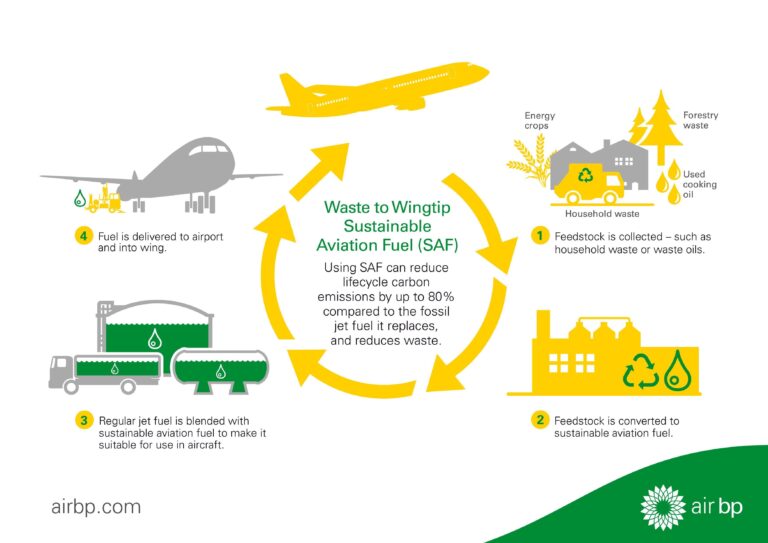Air bp’s Sustainable Aviation Fuel Takes Off at Clermont Ferrand Airport: A New Era in Eco-Friendly Aviation
In a significant advancement for the aviation industry, Air bp has launched its sustainable aviation fuel (SAF) at Clermont Ferrand Airport in France, marking a pivotal step towards reducing the environmental impact of air travel. As global awareness of climate change intensifies, the introduction of SAF provides a promising alternative that can reduce carbon emissions significantly compared to traditional jet fuels. This initiative at Clermont Ferrand is not just a local development; it reflects a broader commitment within the aviation sector to embrace greener practices and foster sustainability. With increasing pressure to adopt eco-friendly solutions, Air bp’s move underscores the urgency of innovation in the pursuit of a more sustainable future for air transport.
Air bp Launches Sustainable Aviation Fuel Initiative at Clermont Ferrand Airport
Air bp has introduced its innovative sustainable aviation fuel (SAF) initiative at Clermont Ferrand Airport, marking a significant step towards reducing the aviation industry’s carbon footprint. This initiative aims to support the growing demand for sustainable solutions within the aviation sector and is a substantial part of Air bp’s commitment to a greener future. By utilizing Sustainable Aviation Fuel, the initiative not only helps in meeting local and international emissions targets but also showcases Air bpŌĆÖs dedication to environmental stewardship.
The launch event highlighted several key aspects of this initiative, including:
- Collaboration: Partnering with airlines and local authorities to enhance the use of SAF.
- Innovation: Leveraging advanced production techniques to create fuel from sustainable sources.
- Accessibility: Ensuring SAF is readily available for various aircraft operating in the region.
| Feature | Benefit |
|---|---|
| Reduces emissions | Lower carbon footprint for flights |
| Local sourcing | Supports regional economies |
| Future readiness | Aligns with regulatory requirements |
This groundbreaking project positions Clermont Ferrand Airport as a leading example in the transition to more sustainable travel practices. As Air bp continues to expand its SAF operations, the airport will play a crucial role in paving the way for a cleaner, more efficient aviation future.
Evaluating the Environmental Impact of Sustainable Aviation Fuel
The introduction of sustainable aviation fuel (SAF) at Clermont-Ferrand Airport marks a pivotal moment in the aviation sector’s transition towards greener alternatives. SAF, designed to significantly reduce greenhouse gas emissions, presents a compelling case for the future of air travel. The environmental benefits include:
- Lower Carbon Emissions: SAF can reduce lifecycle carbon emissions by up to 80% compared to traditional jet fuel.
- Waste Reduction: Derived from renewable sources like agricultural waste, SAF helps minimize reliance on fossil fuels.
- Improved Air Quality: The use of SAF results in fewer particulates and nitrogen oxides, leading to cleaner air around airports.
To assess its overall impact, it’s crucial to consider not just emissions but also production and procurement processes. A transparent evaluation framework can guide the industry in optimizing SAF’s benefits. The following table summarizes key metrics related to the environmental footprint of SAF:
| Metric | Traditional Jet Fuel | Sustainable Aviation Fuel (SAF) |
|---|---|---|
| CO2 Emissions (g per MJ) | 94 | 20 |
| Renewable Content (%) | 0 | 50-100 |
| Production Waste (%) | 20 | 5 |
By understanding these metrics, stakeholders can make informed decisions on integrating SAF more widely, ultimately leading to a transformative impact on the aviation industry’s role in climate change mitigation.
The Role of Local Partnerships in Advancing Sustainable Aviation
In the pursuit of sustainable aviation, local partnerships are proving to be invaluable catalysts for innovation and implementation. Collaborations among stakeholdersŌĆösuch as airports, local governments, and private sector playersŌĆöcreate a robust framework for advancing sustainable aviation fuel initiatives. These alliances facilitate shared resources and knowledge, ensuring that best practices are applied and sustainable solutions are reached quicker. For example, partnerships can enable joint research projects that analyze local environmental impacts, paving the way for tailor-made sustainable solutions that serve both the community and the aviation industry.
Moreover, local partnerships can drive community engagement and awareness around sustainable practices. Initiatives like educational workshops, public forums, and collaborative events help foster a culture of sustainability among local populations and industry players alike. Such engagement is crucial, as it not only raises awareness about the benefits of sustainable aviation fuels but also encourages local businesses to invest in greener technologies. As these entities work together, they help to build a comprehensive ecosystem that supports the long-term viability of sustainable aviation, driving both regional growth and environmental stewardship.
Future Directions for Sustainable Aviation in France and Beyond
As sustainable aviation fuel (SAF) initiatives gain momentum, France stands poised as a leader in the global shift toward eco-friendly air travel. The implementation of Air bpŌĆÖs sustainable aviation fuel at Clermont Ferrand Airport is a significant step, showcasing the country’s commitment to reducing carbon emissions in the aviation sector. This move is expected to catalyze a broad array of future developments, including:
- Innovative Fuel Technologies: Continued investment in research and development to enhance SAF production processes.
- Infrastructure Improvements: Upgrades to airport facilities to support SAF distribution and storage.
- Partnerships and Collaborations: Strengthening ties between governments, airlines, and fuel providers to create a more sustainable aviation ecosystem.
Beyond national borders, the collaborative efforts in sustainable aviation are set to inspire global initiatives that focus on environmental preservation. As countries strive to meet the targets set by the Paris Agreement, it’s essential to explore international partnerships that could amplify efforts in SAF production and use. Potential strategies might include:
- International Standards: Development of uniform regulations and safety guidelines for SAF implementation across different markets.
- Shared Best Practices: Creating platforms for knowledge exchange to foster innovation in sustainable aviation practices.
- Incentives for Adoption: Financial models that encourage airlines to transition to SAF and invest in sustainability initiatives.
In Retrospect
In conclusion, Air bp’s launch of sustainable aviation fuel at Clermont Ferrand Airport marks a significant step forward in the aviation industry’s commitment to environmental sustainability. By providing a cleaner alternative to traditional fuels, Air bp not only aligns itself with global emission reduction goals but also paves the way for other airports and airlines to adopt greener practices. As the aviation sector continues to grapple with the pressing challenges of climate change, initiatives like this are crucial in laying the groundwork for a more sustainable future in air travel. Stakeholders will be watching closely as the impact of this pioneering project unfolds, potentially setting a precedent for airports worldwide to follow suit.




